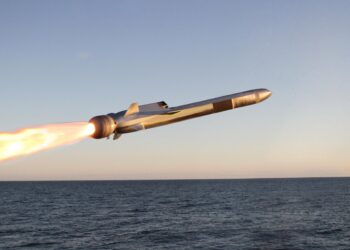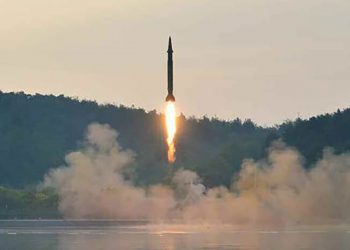UPI, Most observers believe that neither Pakistan nor India has so far deployed nuclear warheads combined with delivery systems, says the latest congressional report on nuclear threat in South Asia.
The report by the Congressional Research Service, which provides policy guidelines to U.S. lawmakers, says that India and Pakistan accelerated nuclear weapons development, and possibly, deployments after testing their devices in May 1998. Both countries, however, decided to keep the warheads separate from delivery systems to avoid accidents and theft.
Both India and Pakistan possess nuclear-capable missiles as well as aircraft. They also regularly test short- and medium-range missiles to improve their delivery systems.
The report points out that there are two basic nuclear risks in South Asia: Nuclear material or weapons f alling into the hands of terrorists or a miscalculation leading to a preemptive strike and thus to a nuclear war.
The threat of terrorism, the report says, calls primarily for greater physical security at weapons sites and places where nuclear material is produced or stored, particularly weapons-grade material, such as highly enriched uranium or separated plutonium. For dealing with the threat of accidental nuclear war, the report suggests making the nuclear weapons safer. For reducing the risk of preemptive or sudden war, the report advises enhancing command and control and, if possible, transparency between the two rival states which have already fought three wars since their independence from Britain in 1947.
In the summer of 1999, they came close to the first-ever war between two nuclear states, sounding alarm bells across the world.
According to the CRS report there are two ways of making nuclear weapons more se cure: Through insensitive high explosives and by shaping the cores so that they will not give a nuclear yield if improperly detonated. But the report says that some experts fear that making nuclear weapons safer also makes them more deployable and thus increases the risk of their use.
Explaining the current strategy of separating warheads from delivery systems, the CRS notes that both India and Pakistan keep their fissile material components separately from the rest of the warhead. Such physical separation helps deter unauthorized use and complicates theft.
In the early years of the U.S. nuclear weapons program, fissile material components of warheads were physically separated; in the earliest bombs, the two were mated in the bomb-bay of the aircraft. When nuclear missiles entered the U.S. inventory, the warheads were physically separated from the missiles.
The report says that to avoid an accidental war, it is also im portant to have set rules and procedures for authorized use of a nuclear weapon. But it is not clear what those rules are for India or Pakistan, the report adds.
The Congressional Research Service acknowledges that India and Pakistan have been moving toward more structured nuclear command-and-control authority, organization, and strategic planning but warns that it is not clear whether they have also implemented the two-man rule. Under this system, a concurrent involvement of at least two people is required to fire a weapon. It is also not clear what other procedures have been adopted to prevent unauthorized use, the report adds.
“There is no reliable information on where fissile material is shaped or machined into components for weapons, or where fissile cores are kept if they are separated from other weapon components and delivery systems for India and Pakistan,” according to the report.
Focusing on Pakistan, the CRS points out that some observers believe Islamabad has probably distributed its nuclear weapons in a number of tightly secured facilities at different locations throughout the country.
The CRS notes that in Pakistan physical security is provided by the military. India has kept strong civilian oversight of the weapons program, with the military kept predominantly at arm's length. However, the details of security in both cases are unknown.
In April 2000, the Indian government ended independent safety oversight at the Bhabha Atomic Research Center, the “nerve center” of the Indian nuclear weapons program. Some analysts have interpreted this change as an indication of accelerated nuclear weapons work at BARC, the report says.
The CRS also refers to an Oct. 2, 2001, statement by Pakistan's Foreign Ministry saying, “Our nuclear assets are 100 percent secure, under multiple custody.” The new media interpreted this as indicatin g Pakistan had moved nuclear weapons components to several undisclosed locations, the report adds.
Subsequently, President Pervez Musharraf reorganized elements of the Pakistan Atomic Energy Commission and investigated several nuclear weapons scientists who reportedly had ties to Islamic extremists.
The CRS notes that most of the material and facilities in India and Pakistan is not subject to international safeguards. In India, there are safeguards on six reactors: Tarapur 1 and 2, which are low-enriched uranium-fueled power reactors; Rajasthan RAPS-1 and -2, which use natural uranium; and Koodankulam-1 and -2, LEU-fueled power reactors.
In addition, the Tarapur plutonium reprocessing facility – Prefre – is safeguarded when fuel is used in the facility and the Tarapur MOX fuel fabrication plant has safeguards when it runs safeguarded material through it. The Hyderabad fuel fabrication plant has partial safeguards.
Key nuclear weapons-related facilities in India that are not subject to inspections by the International Atomic Energy Agency include the Bhabha Atomic Research Center in Trombay, which houses the Cirus and Dhruva research reactors for plutonium production, plutonium reprocessing plants and a pilot-scale uranium enrichment plant.
“These sites, as well as storage sites for weapons-grade material or for weapons themselves could be highly attractive to terrorists because they may contain weapons-usable nuclear material,” the report warns.
Pakistan has IAEA safeguards on a few facilities. The KANUPP power reactor, which uses natural uranium, Chashma-1, LEU-fueled power reactor, and two research reactors at Rawalpindi that have used highly enriched uranium in the past are under international safeguards.
The following facilities are not under safeguards: the Khan Research Laboratories at Kahuta, which includ e a uranium enrichment plant and facilities for fabricating HEU into weapons; centrifuge enrichment plants at Sihala, Golra and Wah/Gadwal, the Chashma reprocessing plant, and PINSTECH and SPINSTECH facilities related to reprocessing at Rawalpindi.
“These nuclear material production sites, as well as weaponization, storage and assembly sites, could be high-value targets for terrorists,” the report cautions.









